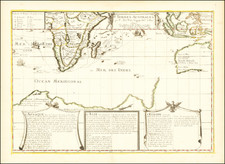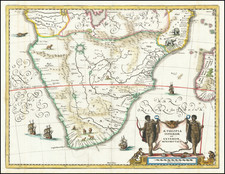Wyld's Reissue of Faden's Detailed Map of the Cape Town Region.
1838 edition of this highly detailed map of the Dutch Colony on the Cape of Good Hope, first published in 1782.
This attractive map gives an idea of contemporary knowledge of the area from "Klipping Eyland" to "Cape Falso". Of note is the addition in this edition of "Muyzenberg about 1300 feet high." About 20 farms and settlements are named as well as Constantia and Stellen bosch. The Drakenstein mountains form the eastern boundary of the Cape.
The cartouche is a cliff bearing the title with palms, huts, and an elephant in the foreground. A key identifies points on the mainland and another the islands and bays.
James Wyld Sr. (1790-1836) was a British cartographer and one of Europe’s leading mapmakers. He made many contributions to cartography, including the introduction of lithography into map printing in 1812.
William Faden, another celebrated cartographer, passed down his mapmaking business to Wyld in 1823. The quality and quantity of Faden’s maps, combined with Wyld’s considerable skill, brought Wyld great prestige.
Wyld was named geographer to Kings George IV and William IV, as well as HRH the Duke of York. In 1825, he was elected an Associate of the Institution of Civil Engineers. He was one of the founding members of the Royal Geographical Society in 1830. Also in 1830, his son, James Wyld Jr., took over his publishing house. Wyld Sr. died of overwork on October 14, 1836.
James Wyld Jr. (1812-87) was a renowned cartographer in his own right and he successfully carried on his father’s business. He gained the title of Geographer to the Queen and H.R.H. Prince Albert. Punch (1850) described him in humorous cartographic terms, “If Mr. Wyld’s brain should be ever discovered (we will be bound he has a Map of it inside his hat), we should like to have a peep at it, for we have a suspicion that the two hemispheres must be printed, varnished, and glazed, exactly like a pair of globes.”

![[ Cape of Good Hope / Cape Town, South Africa ] The Dutch Colony of the Cape of Good Hope by L.S. De La Rochette MDCC XCV By William Faden](https://storage.googleapis.com/raremaps/img/small/96510.jpg)








![(South Africa) Jeppe's Map of the Transvaal or S.A. Republic and Surrounding Territories [Six-Sheet Map]](https://storage.googleapis.com/raremaps/img/small/84245.jpg)
![[Cabo de Boa Esperanca / Baya de Saldanha]](https://storage.googleapis.com/raremaps/img/small/52494.jpg)
![[South Africa] Charte der Sudspize von Africa oder des Hottentotten und Caplands . . . 1806](https://storage.googleapis.com/raremaps/img/small/54869.jpg)


![[South Africa / Namibia / Angola] Coste Occidentale D'Afrique Depuis le XIe. Degre De Latitude Meridional, Jusqua'au Cap de Bonne Esperance Tiree de la Carte de l'Ocean Meridional . . . 1739](https://storage.googleapis.com/raremaps/img/small/77033.jpg)